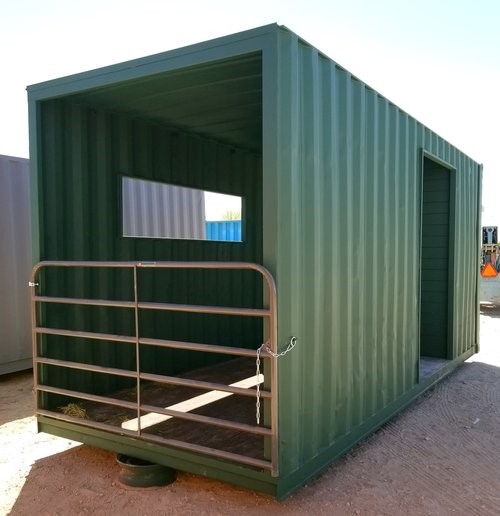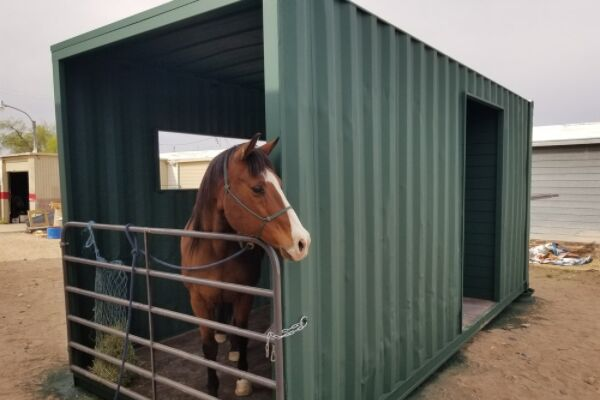In recent years, innovative construction methods have revolutionized how we think about building structures for various purposes—residential, commercial, and agricultural. Among these innovations, shipping container structures have gained significant popularity due to their affordability, durability, and environmental sustainability.
For horse owners and equine enthusiasts, the concept of a shipping container horse barn offers an exciting alternative to traditional barn construction. This modern approach combines rugged strength with eco-friendliness, providing a safe, customizable, and cost-effective shelter for your horses.
In this comprehensive guide, we will explore everything you need to know about shipping container horse barns—from their benefits and design considerations to construction process and maintenance tips. Whether you’re a seasoned equestrian or a newcomer considering a sustainable shelter, this article aims to be your ultimate resource.
What is a Shipping Container Horse Barn?
A shipping container horse barn is a horse shelter constructed by repurposing standard steel shipping containers—typically 20-foot, 40-foot, or larger units—into functional stables. These containers, originally designed for transporting goods across the globe, are transformed into equine shelters through modifications such as ventilation, insulation, stall divisions, and entry/exits.
Why Use Shipping Containers for Horse Barns?
- Durability and Strength: Steel containers are built to withstand harsh marine environments, making them remarkably tough and resistant to pests, fire, and weather damage.
- Cost-Effectiveness: Compared to traditional barn construction, shipping container barns often require less material and labor, reducing overall costs.
- Eco-Friendly: Repurposing decommissioned containers reduces waste and promotes sustainable building practices.
- Customizable Design: Containers can be modified extensively—adding windows, doors, ventilation, insulation, and interior stalls—to suit your specific needs.
- Mobility and Flexibility: Portable and modular, these structures can be relocated or expanded with relative ease.
Benefits of Shipping Container Horse Barns
1. Enhanced Durability and Security
Steel containers are inherently robust, offering superior protection against weather elements, predators, and accidental impacts. Their sturdy construction ensures the safety of your horses, especially in areas prone to storms or extreme weather.
2. Cost-Effective Construction
Compared to traditional barns that require extensive foundation work, framing, roofing, and finishing, shipping container barns can be assembled faster and with fewer materials, leading to significant cost savings.
3. Eco-Friendly and Sustainable
Reusing shipping containers promotes recycling and reduces environmental footprint. Plus, insulation and ventilation modifications can improve energy efficiency, minimizing heating and cooling costs.
4. Customizable and Modular
Containers can be modified to include stalls, hay storage, tack rooms, and wash bays. Multiple units can be combined to create larger facilities or specialized structures.
5. Quick Installation and Portability
Once modified, shipping container barns can be installed rapidly—often within days—and can be relocated if needed. This flexibility appeals to mobile or temporary farm setups. Container malls
6. Low Maintenance
Steel containers are resistant to pests like termites and do not rot like wood. With proper treatment, they require minimal upkeep over their lifespan.
Design Considerations for Shipping Container Horse Barns
While shipping containers offer many advantages, designing an effective and safe horse barn requires careful planning. Below are key factors to consider:
1. Container Size and Configuration
- Size Selection: Common sizes are 20 ft and 40 ft containers. For horse stalls, 40 ft containers are preferable due to their ample width and length.
- Number of Units: Decide whether to use a single container or multiple units combined for larger facilities.
- Stacking and Layout: Plan for vertical stacking (if permitted) or side-by-side arrangements, considering accessibility and space flow.
2. Ventilation and Airflow
Proper ventilation is critical to prevent respiratory issues and moisture buildup. Incorporate:
- Vents and Exhaust Fans: Strategically placed to promote airflow.
- Windows and Louvers: For natural ventilation and light.
- Openings: Large side doors or roll-up doors for easy access and cross-ventilation.
3. Insulation and Temperature Control
Steel conducts heat and cold, so insulation is vital:
- Spray Foam Insulation: Provides high R-value and seals gaps.
- Rigid Board Insulation: Suitable for exterior or interior lining.
- Climate Considerations: In colder regions, additional heating solutions may be necessary.
4. Interior Stalls and Dividers
Design stalls with durable materials, ensuring:
- Adequate Space: Minimum of 12×12 ft for adult horses.
- Safety: Rounded edges, smooth surfaces, and proper drainage.
- Partitions: Made from treated wood, metal, or composite materials.
5. Lighting and Electrical Systems
Natural light is preferable, but supplemental lighting ensures safety and visibility. Use energy-efficient LED fixtures and install outlets strategically.
6. Water Supply and Drainage
Install:
- Automatic Waterers: For continuous access to fresh water.
- Drainage Systems: To prevent water accumulation and facilitate cleaning.
7. Exterior Modifications
- Roofing: Add overhangs or awnings for rain protection.
- Exterior Finishes: Paint or coatings to prevent rust and improve aesthetics.
- Access Ramps: For easier entry, especially for elderly or injured horses.
Construction Process of a Shipping Container Horse Barn
Transforming a standard shipping container into a functional horse barn involves several steps:
Step 1: Planning and Design
- Assess your needs, available space, climate, and budget.
- Create detailed plans, including layout, modifications, and utilities.
Step 2: Container Selection and Preparation
- Source containers from reputable suppliers or salvage yards.
- Inspect for damage, corrosion, or structural issues.
- Clean and prepare the exterior surface.
Step 3: Structural Modifications
- Cut openings for doors, windows, and ventilation.
- Reinforce cut edges to prevent rust and injury.
- Install doors, windows, vents, and exhaust fans.
Step 4: Insulation and Interior Finishing
- Apply insulation materials to interior walls and ceiling.
- Install stall dividers, flooring (such as rubber mats or concrete with bedding), and drainage systems.
- Add electrical wiring and lighting fixtures.
Step 5: Exterior Enhancements
- Apply weather-resistant coatings or paint.
- Install roofing overhangs or awnings.
- Set up ramps or thresholds.
Step 6: Site Preparation and Installation
- Prepare a level foundation—gravel bed, concrete slab, or piers.
- Position containers according to the design.
- Secure containers to foundations for stability.
Step 7: Final Inspection and Setup
- Ensure all modifications meet safety standards.
- Stock with bedding, water, and feed supplies.
- Introduce horses gradually and monitor their adaptation.
Maintenance Tips for Shipping Container Horse Barns
Proper maintenance ensures longevity and safety:
- Regular Inspection: Check for rust, corrosion, or structural damage.
- Painting and Coating: Reapply protective paint to prevent rust.
- Ventilation Checks: Ensure vents and fans are operational.
- Cleaning: Remove manure, bedding, and debris daily.
- Pest Control: Prevent rodents and insects.
- Water System Maintenance: Keep waterers clean and functional.
- Structural Repairs: Address damages promptly.
Cost Analysis: Shipping Container Horse Barns vs. Traditional Barns
| Aspect | Shipping Container Barn | Traditional Barn |
|---|---|---|
| Initial Cost | Generally lower due to less construction material | Higher due to extensive framing, roofing, and finishing |
| Construction Time | Rapid, often within days | Several weeks to months |
| Maintenance | Low, steel resistant to pests | Moderate to high, depending on materials used |
| Customization | Highly customizable | Customizable but often more expensive |
| Mobility | Portable, can be relocated | Fixed structure |
Note: Costs vary based on size, location, modifications, and labor.
Sustainability and Environmental Impact
Shipping container barns exemplify eco-friendly construction by repurposing existing materials. They reduce waste and minimize the carbon footprint associated with traditional building methods. Additionally, insulation and ventilation enhancements can improve energy efficiency, further reducing environmental impact. Animal care
Case Studies and Real-World Examples
Many farms and equestrian facilities have successfully adopted shipping container barns:
- Small-Scale Hobby Farms: Using single units for a few horses.
- Large Commercial Equestrian Centers: Combining multiple containers into complex structures with stalls, tack rooms, and wash bays.
- Mobile Horse Shelters: Designed for temporary or seasonal use, easily relocated to different pastures.
For inspiration and detailed examples, visit Equip Intermodal, which offers a variety of shipping container solutions tailored to agricultural needs.
Future Trends in Shipping Container Horse Barns
Advancements in modular construction, insulation technologies, and sustainable materials are set to make shipping container barns even more attractive:
- Smart Monitoring Systems: Sensors for temperature, humidity, and security.
- Green Roofs and Solar Panels: Enhancing sustainability.
- Prefabricated Kits: Simplifying installation for DIY enthusiasts.
- Hybrid Structures: Combining containers with traditional materials for aesthetic and functional benefits.
Conclusion
A shipping container horse barn combines modern engineering, sustainability, and practicality—making it an excellent choice for horse owners seeking durable, affordable, and customizable shelters. With proper planning, design, and maintenance, these structures can serve your equine needs for decades while minimizing environmental impact.
Whether you’re looking for a small, portable shelter or a large, permanent facility, shipping container barns offer flexibility and resilience unmatched by traditional construction. Embrace this innovative approach and provide your horses with a safe, comfortable, and eco-friendly home.
Additional Resources
- Equip Intermodal: Your partner in shipping container solutions.
- American Equine Association: Tips on horse shelter requirements.
- Green Building Advisor: Sustainable construction practices.
If you’re interested in building or purchasing a shipping container horse barn, consult with experienced professionals to customize your design and ensure compliance with local safety standards.



